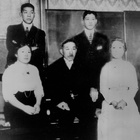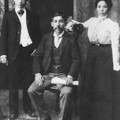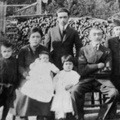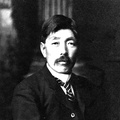Reconciling Conflicting Claims
Japanese began settling in Canada in the late 19th and early 20th century. Earlier, some had visited as sailors on sealing ships, as shipwrecked sailors picked up at sea, or as short-time sojourners—all returning to Japan. In 1880 an Imperial Japanese Naval training ship brought over 300 cadets to Esquimalt Harbour for a week’s visit. But who was the first Japanese to come and stay? Manzo Nagano’s name is the most well-known of the early immigrants, but was he really the first? This article will examine three candidates; judge for yourself.
* * * * *
MANZO NAGANO—Did He Come in 1877?
Sometime in the early 1970s Toyoaki (Toyo) Takata chanced upon a paragraph in a 1938 book by Charles Young and Helen Reid, The Japanese Canadians, which claimed that Manzo Nagano had come to Canada as a sailor in 1877 and settled in New Westminster.1 The quote was attributed to a UBC master’s thesis written by Rigenda Sumida in 1934. Sumida had based his statement on an earlier work by Jinshiro Nakayama written in Japanese in 1921.
Takata was delighted to discover that Nagano had arrived in 1877. He wanted to help revitalize the Japanese community across Canada which had been dispersed during the Pacific War. This could be the key to uniting the community: encouraging the Japanese Canadian community all across Canada to celebrate 1977 as the centennial of the arrival of the first Japanese immigrant to Canada. The centennial celebration proved to be a tremendous success that helped connect Japanese Canadians across Canada and raise their profile in Canada in general.
Nakayama’s book runs to 1,239 pages. In it he tried to list all Japanese immigrants living in Canada, their children and their place of origin in Japan. Within these pages is his 1920 interview with 65-year-old Nagano. Nakayama’s interest in Nagano had been sparked through reading an earlier study, Sumio Ishidate’s book, written in Japanese in 1909, the Kanada Doho Hatten Shi, 1. Five pages give the early history of Victoria and describe Japanese organizations in the city. Ishidate had interviewed members of this community, including Manzo Nagano. It is illuminating to read what Sumio Ishidate wrote about Victoria in 1909.
We Japanese have travelled more than 4,500 nautical miles across the Pacific to step upon Canadian soil for the first time. How many years ago, what year? Already thirty or more years have passed. There is no hard evidence in existence. We can only speculate. Summing up the recollection of the old-timers, it seems Japanese began to come at least by the 10th year of Meiji (1877).
Manzo Nagano, from Nagasaki Prefecture, who runs a miscellaneous goods and Japanese curio shop in Victoria, is one of the earliest. I have heard it from him that he landed in Victoria Harbour in March of the 10th year of Meiji. Later, in the autumn of the 17th year of Meiji (1884), several Japanese landed at Victoria . . . Kisuke Mikuni and Tomekichi Homma who live in Vancouver district are people who came during that period.2
In 1909 Nagano did not claim to be the first immigrant. Sumio Ishidate only said that he was one of the earliest. “Thirty or more years” before 1909 would mean that sometime during the 1870s, it was believed, the first Japanese had come to Canada. Note that in 1909 Nagano said he landed in Victoria harbour. Ishidate clearly states as noted above, “There is no hard evidence in existence. We can only speculate.”
Eleven years later, on the other hand, when Nagano talked to Jinshiro Nakayama, his story had vastly expanded. Below are quotes from Nakayama’s interview with Nagano in 1920 in Victoria. The story of Nagano is found on pages 37-42 of his book, Kanada Doho Hatten Taikan (Encyclopedia of Japanese in Canada), Vancouver, 1922. Below is Rigenda Sumida’s condensed translation in 1934. Note that Nagano is now claiming he arrived in New Westminster not Victoria as he had told Ishidate in 1909.
Is he a man of destiny or a man who builds his own destiny? I cannot know with confidence that I know the answer. He was illiterate as he had received no formal education, and thus he never used sophisticated ways of expression. . .Manzo Nagano at the age of 19 became a sailor and in 1877 came to Canada but remained in New Westminster when his boat left. He borrowed a boat and with an Italian partner, engaged in salmon fishing in the Fraser River, the forerunner of the hundreds of Japanese fishermen to follow.
In 1880, he came to Vancouver, then more popularly known as Gastown, where he was a longshoreman. But he was apparently an adventurous spirit for, unable to settle down, he sailed to Shanghai, then to Nagasaki, then to Hong Kong and in 1884 back to New Westminster, at which time he found seven or eight Japanese engaged in fishing.
He went to the United States and once more entered fishing, but one day was driven by a storm up the Fraser River in 1886. This time, he found five Japanese fishermen in New Westminster. He returned to Seattle and entered business, but in 1891 returned to Japan.3
In 1892, he again came to Canada, this time to Victoria, where he opened a store, and in 1894 initiated the salt-salmon industry in British Columbia. In 1898, he brought a wife to Canada and finally settled down in Victoria.4
Nakayama’s version of Nagano’s story contradicts key points of the earlier Ishidate version. The place of his arrival is only the first of many disagreements. Nagano claimed that during those years after 1877 he worked as a deckhand, fisherman, longshoreman, and entered into business in Seattle—before returning to Japan in 1891.
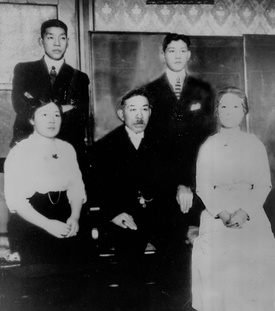
In Nagano’s account given to Nakayama, he mentioned that he had returned to Japan in 1898 to marry his wife, Tayoko. What he left out of his story was that she was his third wife. Evidence confirms that Nagano married twice in Japan between 1886 and 1891 (years he claimed he was at sea, in New Westminster or Seattle). Nagano’s first wife, Sayo, produced a son Tatsuo (George) in 1887 in Japan. Sayo died in Japan (although no record of her death can be found).
When Nagano arrived in Victoria in 1892, he was accompanied by his second wife Tsuya. She gave birth to a daughter Haru the next year. Unfortunately both died within seven months and are buried in Ross Bay Cemetery in Victoria.
His third wife, Tayoko Ishi from Tokyo, was 32 when she married Nagano. Frank Terumaro was born on October 3, 1898, in Victoria, Tayoko’s only child. Nagano’s oldest son by his first wife, George, had accompanied Tayoko on the move to Victoria. After Frank’s birth there were no more children. Both boys grew to manhood and spent the rest of their lives in North America.
The first fact of Nagano’s story above that can be corroborated is his claim to have come to Canada in 1892. In 1893 he is listed in the Victoria city directory as J. M. Nagano, (“J” was for “Jack”, his adopted English name). He was operating the Oriental Bazaar at 90 Douglas Street.5 Since the information would have been gathered the year before, he was definitely in the city in 1892.
Nagano was 37 years old when he arrived with his second wife, Tsuya, 22 years old. While Nagano told Nakayama that he had been away from Japan from 1877 to 1891, this would be impossible since during that time he had produced a son; George’s marriage certificate states that he was born in Japan. Other proof that Nagano first came to Canada in 1892 and not in 1877 is found on his naturalization papers of 1897, when he stated under oath that he had come to Canada in 1892.6 Over the next two decades Manzo Nagano is included in the Victoria city directories at different addresses.
Notes:
1. Charles H. Young and Helen R. Y. Reid, The Japanese Canadians. University of Toronto Press, Toronto, 1938.
2. Sumio Ishidate, Kanada Doho Hatten-shi 1, (History of the Japanese in Canada, 1), Tairiku Nippo-sha, Vancouver, 1909, 46-51.
3. In a more complete translation Nagano said he returned to Yokohama in 1891 and opened a western-style restaurant but it failed so he decided to go to Victoria.
4. Rigenda Sumida, “The Japanese in British Columbia,” MA thesis, manuscript, UBC Library, 1934. (translation from pages from the above book, 37-42).
5. Williams Official British Columbia Directory, January 1893, p. 576.
6. B. C. County Court (Victoria) a naturalization applications and oaths of allegiance, 1859-1917, BC Archives, Royal BC Museum.
*This article was originally published in the Nikkei Images, A publication of the Nikkei National Museum & Cultural Centre (Volume 28, No. 1).
© 2023 Ann-Lee Switzer, Gordon Switzer



